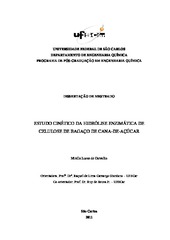Estudo cinético da hidrólise enzimática de celulose de bagaço de cana-de-açúcar
Resumo
This work presents a kinetic study of the enzymatic hydrolysis of three cellulosic substrates: filter paper (FP), used as a de-lignified substrate model; sugarcane bagasse (SB) steam exploded; and acid treated SB, the last two treated with 4% NaOH. All SB were chemically characterized. Hydrolysis experiments to study the influence of agitation and substrate concentration were performed in shaker, using Accellerase® 1500, Genencor, at pH 4.8, in 50mM sodium citrate buffer. To verify the substrate concentration effect, cellulose load (weightsubstrate/weighttotal) was 0.5%-13% (for FP) and 0.99%-9.09% (for SB). For FP, the role of the external mass transport resistance was not significant when the agitation speed was in the range 150-300 rpm. It was possible to fit a pseudo-homogeneous Michaelis-Menten model for substrate concentrations up to 13% (w/w). Preliminary tests fitting the model proposed by Chrastil (CHRASTIL J. Enzymic product formation curves with the normal or diffusion limited reaction mechanism and in the presence of substrate receptors, Int. J. Biochem., v. 20, No. 7, p. 683, 1988) indicated that the role of diffusion through the external film was a more relevant feature for steam exploded SB than for FP, at higher concentrations of substrate. It was possible to fit a pseudo-homogeneous model for steam exploded SB, within a range of cellulose concentrations from 0.99% to 3.85% (w/w). Product inhibition had to be considered by the model. For higher loads of steam exploded SB, a modified Michaelis- Menten model, appropriate for heterogeneous systems with high diffusion resistance, was fitted. Finally, for the highly recalcitrant acid treated SB, Chrastil models were fitted. As expected, the complexity of this system regarding to the substrate and to the pool of enzymes acting in synergy, makes difficult the use of one single lumped parameter model for all hydrolysis operation conditions.
